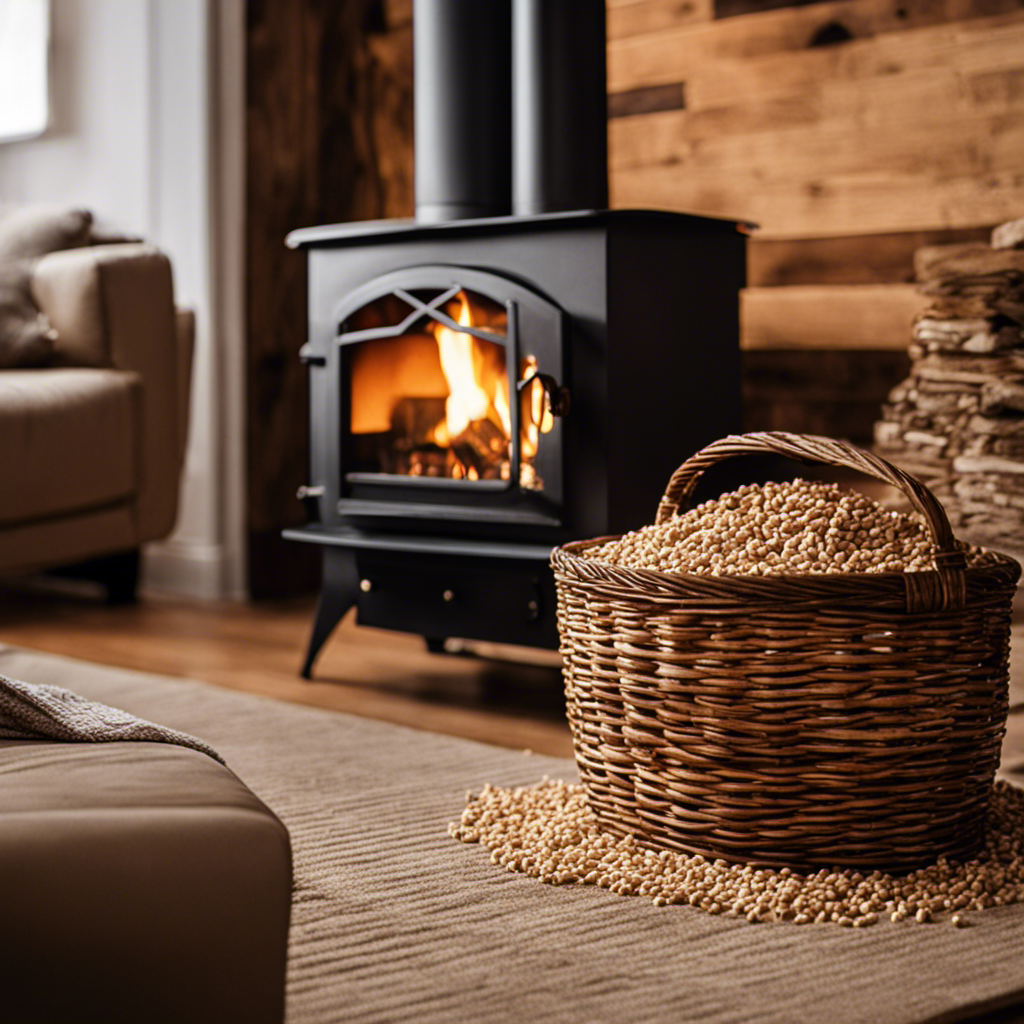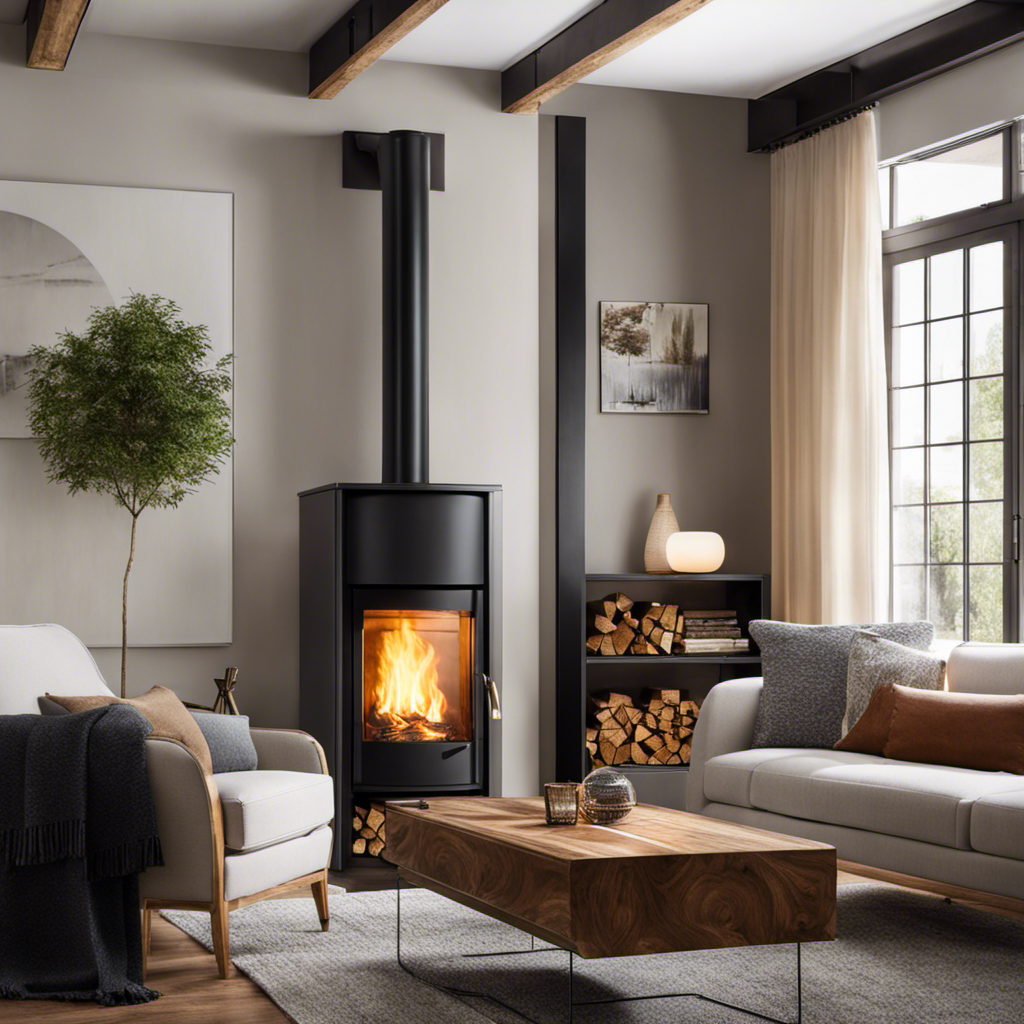Finding budget-friendly wood pellets for your pellet stove can seem like looking for a needle in a haystack. But don’t worry, because I’ve compiled all the crucial information you need right here.
In this article, I’ll break down the factors that affect wood pellet prices and give you an idea of the average costs in different regions. Plus, I’ll share some tips on how to find the best deals and calculate your heating expenses.
So sit back, relax, and let’s dive into the world of wood pellets!
Key Takeaways
- Factors affecting wood pellet prices include average cost of production, cost of raw materials, transportation costs, competition among manufacturers, price comparison for consumers, supply and demand, seasonal fluctuations, and regional differences.
- Wood pellets have a lower price per unit compared to gas and offer higher heating efficiency. They also have a positive environmental impact by reducing greenhouse gas emissions.
- The demand for wood pellets affects their availability and prices, while the availability of raw materials and transportation costs influence the final price. It is important to find the best deals without compromising quality and to compare prices and store wood pellets properly.
- Bulk purchases of wood pellets are cost-effective, with potential savings due to lower per-unit prices and long-term savings from a larger supply lasting the entire heating season. Storage considerations are important for maintaining quality, and a cost comparison between bulk and retail prices should be considered.
Factors That Affect Wood Pellet Prices
There are several factors that can affect the prices of wood pellets for a pellet stove. One of the main factors is the average cost of production. The cost of raw materials, such as sawdust or wood chips, can vary depending on availability and demand.
Additionally, transportation costs play a significant role in determining the final price of wood pellets. Since most wood pellets are produced in rural areas and need to be transported to urban regions, shipping expenses can add up quickly.
Another factor that affects wood pellet prices is competition among manufacturers. Price comparison is an essential step for consumers looking for affordable options. Manufacturers often offer different pricing strategies to attract customers, so it’s important to compare prices before making a purchase decision.
Now let’s explore the average cost of wood pellets in different regions…
Average Cost of Wood Pellets in Different Regions
In different regions, the average cost of wood pellets for a pellet stove varies. Here are some key factors that influence the price of wood pellets:
-
Supply and demand: The availability of wood pellets in a particular region can affect their cost. Higher demand or limited supply can lead to higher prices.
-
Transportation costs: Wood pellets need to be transported from production facilities to retailers, and these transportation costs can impact the final price.
-
Seasonal fluctuations: During winter months when heating demands are high, the cost of wood pellets may increase due to increased demand.
-
Regional differences: The average cost of wood pellets can vary based on regional factors such as proximity to production facilities or availability of alternative heating options.
When comparing the average cost of wood pellets to electric heating or propane heating, it is important to consider factors like energy efficiency, environmental impact, and long-term savings potential.
Comparison of Wood Pellet Prices to Other Heating Fuels
When considering heating options, it’s important to compare the costs of different fuel sources.
In this discussion, I’ll be examining the cost comparison between wood and gas as heating fuels.
Cost Comparison: Wood Vs. Gas
You’ll find that wood pellets for a pellet stove are generally more cost-effective compared to gas. Not only do wood pellets have a lower price per unit, but they also offer a significant cost benefit in terms of heating efficiency.
Wood pellets have a higher energy density than natural gas, meaning they can produce more heat per unit of fuel consumed. This translates to lower overall heating costs and greater savings for homeowners.
Additionally, using wood pellets as a fuel source has a positive environmental impact. Wood is considered a renewable resource, and when burned in pellet form, it emits significantly fewer greenhouse gases compared to burning fossil fuels like natural gas.
These factors make wood pellets an attractive choice for those looking to save money while reducing their carbon footprint.
Moving on to the next section about price difference analysis…
Price Difference Analysis
The cost difference between using wood pellets and gas for heating is influenced by various factors.
One of the main factors affecting availability is the demand for wood pellets. As more people switch to pellet stoves, the demand for wood pellets increases, which can lead to higher prices.
Additionally, the availability of raw materials used in producing wood pellets, such as sawdust and wood shavings, can also impact their cost. If there is a shortage of these materials, it can drive up prices.
Furthermore, transportation costs play a role in determining the final price of wood pellets. The distance between the production facility and the consumer can affect shipping expenses and subsequently impact prices.
Considering these factors affecting availability and demand on prices, it becomes important to find ways to get the best deals on wood pellets without compromising quality or efficiency.
Tips for Finding the Best Deals on Wood Pellets
One of the best ways to find the best deals on wood pellets for your pellet stove is by comparing prices at different stores. When comparing brands, it’s important to consider the quality and heat output of each pellet type. Some brands may offer lower prices but may not burn as efficiently or produce as much heat.
It’s also crucial to properly store your wood pellets to maintain their quality and ensure they last longer. Keep them in a dry area away from moisture and humidity, preferably in a sealed container. This will prevent them from absorbing any moisture that could affect their performance.
Now, let’s explore whether bulk purchases of wood pellets are more cost-effective than buying smaller quantities.
Transition: Now that we have discussed finding the best deals on wood pellets, let’s delve into whether purchasing them in bulk is more cost-effective.
Are Bulk Purchases of Wood Pellets More Cost-Effective?
When considering the cost-effectiveness of bulk purchases of wood pellets, it is important to compare the prices of buying in bulk versus retail.
In many cases, purchasing in bulk can result in significant savings due to lower per-unit prices.
Additionally, when looking at long-term savings potential, buying in bulk allows for a larger supply that can last throughout the entire heating season, reducing the need for frequent trips to the store and potentially saving on transportation costs.
However, it’s crucial to consider storage considerations for bulk purchases as they require adequate space and proper conditions to maintain their quality over time.
Bulk Vs. Retail Prices
Did you know that buying wood pellets in bulk can save you money compared to retail prices?
When it comes to purchasing wood pellets for your pellet stove, there are two options: bulk and bagged.
Bulk purchases involve buying a larger quantity of wood pellets, typically delivered by truck and stored in a designated area.
On the other hand, bagged options are smaller packages of wood pellets that can be easily transported and stored.
In terms of cost comparison, wood pellets are generally more affordable than electric heating.
Wood pellet fuel is known for its high efficiency and low cost per BTU (British Thermal Unit), making it a cost-effective alternative to electric heating.
This makes bulk purchases an attractive option for those looking to maximize savings on their heating expenses.
Speaking of savings potential, let’s delve into the long-term benefits next…
Long-Term Savings Potential
If you buy wood pellets in bulk, you can save money in the long run. Investing in a large quantity of wood pellets upfront may seem like a significant expense, but it is actually a smart long-term investment.
Wood pellets are known for their energy efficiency, making them an excellent choice for heating your home. With their high BTU output and low moisture content, wood pellets provide consistent heat and burn efficiently.
Storage Considerations for Bulk
Properly storing bulk wood pellets is essential to maintain their quality and maximize their heating potential. Here are three important considerations when it comes to bulk storage:
-
Space requirements: Bulk wood pellets require adequate space for storage. The amount of space needed depends on the quantity of pellets you plan to store. It’s crucial to ensure that you have enough room in your storage area to accommodate the volume of pellets you intend to purchase.
-
Ventilation: Proper ventilation is crucial for bulk wood pellet storage. Pellets need airflow to prevent moisture buildup, which can affect their quality and burn efficiency. Make sure your storage area has proper ventilation systems or consider using breathable bags or containers that allow air circulation.
-
Protection from elements: Wood pellets should be stored in a dry and protected environment away from direct sunlight, rain, and extreme temperature fluctuations. Moisture can cause the pellets to deteriorate, while exposure to sunlight can lead to discoloration and reduced heating efficiency.
With these considerations in mind, let’s now explore how we can calculate the cost of heating with wood pellets without breaking the bank.
How to Calculate the Cost of Heating With Wood Pellets
To calculate the cost of heating with wood pellets, you’ll need to consider the price per bag and how many bags you use in a given period. This will allow you to determine the total cost and compare it to other heating options. Let’s break it down with a cost comparison analysis:
| Heating Option | Price per Bag (USD) | Bags Used per Month |
|---|---|---|
| Wood Pellets | $5.00 | 10 |
| Natural Gas | $1.50 | 100 |
| Electric Heater | $0.20 | 500 |
| Oil Furnace | $3.00 | 20 |
| Propane Heater | $2.50 | 30 |
Based on these numbers, we can see that wood pellets are a more affordable option compared to other heating sources like natural gas or oil furnace. By calculating savings and considering your specific usage, you can make an informed decision about which option is best for you.
When using wood pellets, there are also hidden costs to consider such as maintenance, cleaning, and potential repairs.
Hidden Costs to Consider When Using Wood Pellets
When using wood pellets for heating, there are additional costs to consider such as maintenance, cleaning, and potential repairs. These hidden costs can add up over time and impact your overall expenses.
Regular maintenance is crucial to keep your pellet stove running efficiently. This includes cleaning the ash pan, checking for any blockages in the venting system, and inspecting the hopper for any damage or wear. Cleaning supplies and replacement parts can also be an additional expense.
Furthermore, if your pellet stove requires repairs, you may need to hire a professional technician which can be costly. It’s important to factor in these maintenance expenses when budgeting for wood pellet heating.
However, there are ways to save money on wood pellet expenses by implementing energy-saving practices and finding cost-effective suppliers of wood pellets.
Ways to Save Money on Wood Pellet Expenses
There are ways you can save money on your wood pellet expenses by implementing energy-saving practices and finding cost-effective suppliers. Here are some cost saving tips and purchasing strategies that can help you reduce your wood pellet expenses:
| Cost Saving Tips | Purchasing Strategies | Energy-Saving Practices |
|---|---|---|
| 1. Buy in Bulk | 1. Compare Prices | 1. Use a Programmable Thermostat |
| 2. Look for Deals | 2. Purchase Directly from Manufacturers | 2. Seal Air Leaks |
| 3. Consider Pellet Quality | 3. Join Buying Cooperatives | 3. Properly Insulate Your Home |
| 4. Maintain Your Stove | 4. Take Advantage of Seasonal Sales | 4. Use Ceiling Fans to Circulate Heat |
| 5 . Utilize a Pellet Storage Bin |
Frequently Asked Questions
How Long Do Wood Pellets Typically Last in a Pellet Stove?
Wood pellets typically last around 24-48 hours in a pellet stove, depending on the size and model. To maximize efficiency, store pellets in a dry area and follow manufacturer’s guidelines for proper usage and maintenance.
Are There Any Specific Brands of Wood Pellets That Are Known for Their Quality and Affordability?
When it comes to wood pellets for a pellet stove, there are certain brands that stand out for their quality and affordability. By comparing customer reviews and ratings, you can find the best balance between price and performance.
Can Wood Pellets Be Used in Other Types of Heating Appliances, Such as Wood-Burning Fireplaces or Furnaces?
Wood pellets can be used in other heating appliances like wood-burning fireplaces or furnaces. However, it’s important to consider the pros and cons compared to traditional firewood. Wood pellets are not suitable for outdoor fire pits or chimneys.
Are There Any Environmental Considerations to Take Into Account When Using Wood Pellets as a Heating Fuel?
Are there any environmental considerations to take into account when using wood pellets as a heating fuel? Wood pellets have numerous environmental benefits, such as being a sustainable source of energy and producing lower emissions compared to fossil fuels.
What Are Some Common Maintenance Tasks Required for Pellet Stoves When Using Wood Pellets as Fuel?
Common maintenance tasks for pellet stoves include regular cleaning of the hopper and ash pan, inspecting and replacing gaskets, and ensuring proper air flow. Wood pellets offer benefits such as high heat output and reduced emissions.
Conclusion
After diving into the world of wood pellet prices, it’s clear that there are factors that affect their cost. However, by comparing prices in different regions and considering bulk purchases, it’s possible to find the best deals.
Wood pellets can be a cost-effective heating fuel option when compared to other alternatives. It’s important to calculate the overall cost of heating with wood pellets and consider any hidden expenses.
By implementing money-saving strategies, such as purchasing during off-seasons or finding local suppliers, you can save big on wood pellet expenses.
So don’t hesitate, start exploring this efficient and eco-friendly heating solution today!











